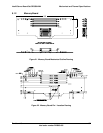
Intel® Server Board Set SE8500HW4 System BIOS
Revision 1.0
Intel order number D22893-001
69
10. System BIOS
The system BIOS is implemented as firmware that resides in flash ROM. It provides hardware-
specific initialization algorithms, basic input/output (I/O) services, and standard Intel Server
Board features. The flash ROM also contains firmware for certain embedded devices that are
supplied by the device manufacturers and are not covered in this document.
The Intel
®
Server Board Set SE8500HW4 BIOS implementation is fully compliant to the Intel
®
Platform Innovation Framework for EFI architecture specifications. This Framework is a set of
robust architectural interfaces that have been designed to accelerate the evolution of innovative,
differentiated, platform designs. The Framework is Intel's recommended implementation of the
EFI Specification for platforms based on all members of the Intel Architecture (IA) family.
A BIOS identification string is used to uniquely identify the revision of the BIOS being used on
the system. The following is an example BIOS identification string:
SHW40.86B.P01.01.00.0001.031820051839
Board ID, ‘SHW40’ for Intel
®
Server Board Set SE8500HW4
OEMID, ’86B’ is used for Intel Server Boards
Build type and version, ‘P01’ for production version 1
Major revision, ‘01’
Minor revision, ‘00’
Build ID, ‘0001’
Build date and time, March 18, 2005 at 18:39
10.1 Advanced Memory Modes
The Intel
®
Server Board Set SE8500HW4 supports several new memory features that allow
flexibility in performance, redundancy, and the ability to upgrade. The System BIOS can be
configured for maximum performance, where memory is up to four-way interleaved; maximum
compatibility, where memory can be hot-added; memory mirroring, where two or four boards are
used to keep a copy of system memory; memory RAID, where four boards are used in a RAID4-
like mode. Only one of these memory modes can be selected at one time, and the BIOS
defaults to maximum performance mode. For the non-redundant modes, support is also
included for memory sparing, where a portion of each Memory Board is reserved for failover.
Hot-replace means the user can replace a Memory Board with another Memory Board of
identical total size. This operation is supported in memory RAID and memory mirroring modes.
Hot-add means the user can add a Memory Board to a previously unoccupied slot. This requires
operating system support and is supported in maximum compatibility and memory mirroring
modes.
Hot-upgrade means the user can replace an existing Memory Board with a Memory Board that
contains more memory capacity. This requires operating system support and is supported by
the memory RAID mode only.


















